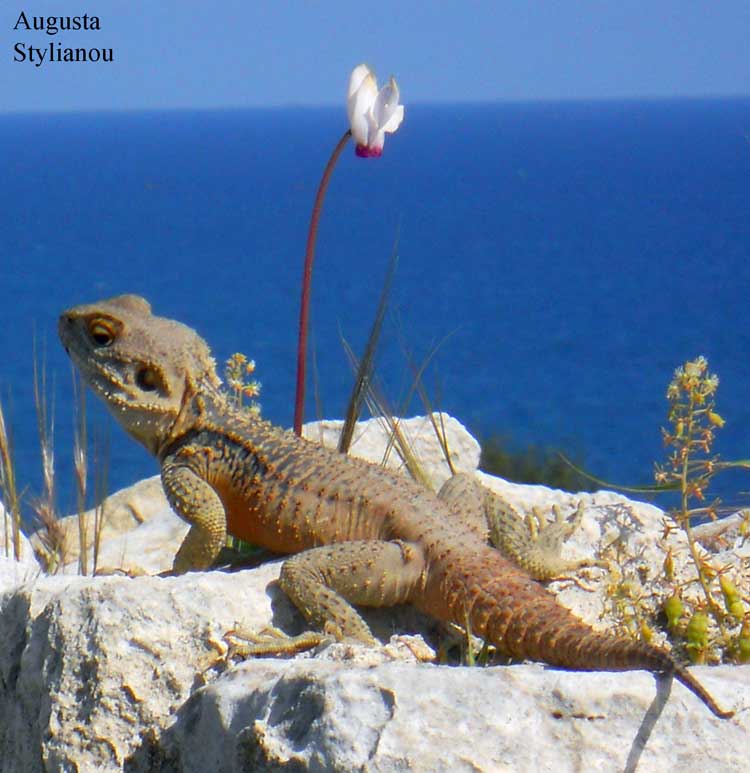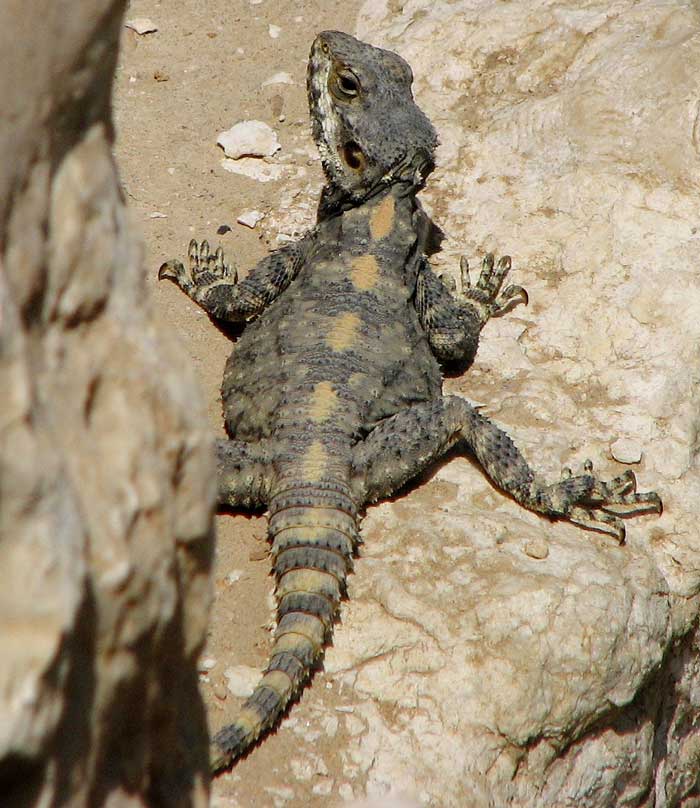
Laudakia stellio , Limassol, Cyprus , Photo: Augusta Stylianou Artist
Superregnum: Eukaryota
Cladus: Unikonta
Cladus: Opisthokonta
Cladus: Holozoa
Regnum: Animalia
Subregnum: Eumetazoa
Cladus: Bilateria
Cladus: Nephrozoa
Superphylum: Deuterostomia
Phylum: Chordata
Subphylum: Vertebrata
Infraphylum: Gnathostomata
Megaclassis: Osteichthyes
Cladus: Sarcopterygii
Cladus: Rhipidistia
Cladus: Tetrapodomorpha
Cladus: Eotetrapodiformes
Cladus: Elpistostegalia
Superclassis: Tetrapoda
Cladus: Reptiliomorpha
Cladus: Amniota
Classis: Reptilia
Cladus: Eureptilia
Cladus: Romeriida
Subclassis: Diapsida
Cladus: Sauria
Infraclassis: Lepidosauromorpha
Superordo: Lepidosauria
Ordo: Squamata
Cladus: Unidentata Episquamata Toxicofera
Subordo: Iguania
Infraordo: Acrodonta
Familia: Agamidae
Subfamilia: Agaminae
Genus: Laudakia
Species: Laudakia stellio
Name
Laudakia stellio (Linnaeus, 1758)
Original combination: Lacerta stellio

Laudakia stellio (*)
References
Linnaeus, C. 1758. Systema Naturae per regna tria naturæ, secundum classes, ordines, genera, species, cum characteribus, differentiis, synonymis, locis, Tomus I. Editio decima, reformata. Holmiæ: impensis direct. Laurentii Salvii. i–ii, 1–824 pp DOI: 10.5962/bhl.title.542: 202. Reference page.
The Reptile Database
European Field Herping Community
Vernacular names
العربية: الحرذون النجمي
Deutsch: Hardun
Ελληνικά, Κυπριακά : Κροκοδειλάκι ,Κουρκούδιαλος, Κουρκουτάς
English: Roughtail Rock Agama, hardim, star lizard
עברית: חרדון מצוי
italiano: Stellione
kurdî: Sûsmar
Nederlands: Hardoen
norsk: Hardun
polski: Hardun
русский: Стеллион, Агама-гардун
Türkçe: Dikenli keler
українська: Агама стеліон
Stellagama is a monotypic genus of agamid lizard, containing the single species Stellagama stellio,[3][1] also known as the starred agama or the roughtail rock agama.
Common names
Common names for S. stellio include dikenli keler, hardim, hardun, kourkoutas (Cypriot Greek), kourkoutavlos, painted dragon, roughtail rock agama, short-toed rock agama, sling-tailed agama, star lizard, starred agama, and stellion.[citation needed]
Geographic range
Stellagama stellio can be found in Greece, Israel, Cyprus, Lebanon, western Asia and northern Egypt; it has also been introduced to Malta.[1]
Description
Stellagama stellio may attain a total length (including tail) of 35 cm (14 in) or slightly longer.[4]
Behaviour and habitat
Like many agamids, S. stellio can change its color to express its mood. It basks on stone walls, rocks, and trees. It is usually found in rocky habitats, and is quite shy, being very ready to dive into cracks to hide from potential predators.[citation needed]
Etymology
The common name "stellion" comes from Latin stellio, stēlio (stelliōn-, stēliōn-), from stella, star.[5] It may have referred to any spotted lizard.[citation needed]
Uses
For the indigenous people of Europe, and perhaps the Middle East, traditionally the excrement of the stellio was a popular medicine for the eyes, also used as a cosmetic, known as cordylea, crocodilea or stercus lacerti (i.e. 'lizard shit'), the faeces being imported to European pharmacies from the Levant - a rarer and more potent form was acquired from monitor lizards in olden days (stercus magni lacerti). The dung was used to improve one's eyesight, as well as take away any itches and cure cataracts (webbe).[5][6] Muslims killed them, for it was believed that the lizards were mocking their faith, by lowering their heads in imitation of prayer.[6]
Subspecies
There are several subspecies, and S. stellio is likely a species complex.[1] More research will be done, and this species may yet be split into several species.[3]
The following seven subspecies, including the nominotypical subspecies, are recognized as being valid.[2]
Stellagama stellio brachydactyla (Haas, 1951)
Stellagama stellio cypriaca (Daan, 1967)
Stellagama stellio daani (Beutler & Frör, 1980)
Stellagama stellio picea (Parker, 1935)
Stellagama stellio salehi Y. Werner in Lachmann et al., 2006
Stellagama stellio stellio (Linnaeus, 1758)
Stellagama stellio vulgaris (Sonnini & Latreille, 1802)
Nota bene: A trinomial authority in parentheses indicates that the subspecies was originally described in a genus other than Stellagama.
References
Amr, Z.S.S., Al Johany, A.M.H., Akarsu, F., Üzüm, N., Kumlutaş, Y., Baha El Din, S., Lymberakis, P., Hraoui-Bloquet, S., Ugurtas, I.H., Werner, Y.L., Disi, A.M., Tok, V., Sevinç, M., Sadek, R., Crochet, P.-A., Kaska, Y., Avci, A. & Yeniyurt, C. (2012). "Stellagama stellio". IUCN Red List of Threatened Species. 2012: e.T157247A743714. doi:10.2305/IUCN.UK.2012.RLTS.T157247A743714.en. Retrieved 21 February 2022.
Species Stellagama stellio at The Reptile Database www.reptile-database.org.
Baig KJ et al. (2012). "A morphology-based taxonomic revision of Laudakia Gray, 1845 (Squamata: Agamidae)". Vertebrate Zoology 62 (2): 213-260. (Stellagama, new genus, p. 222).
"Stellagama (=Laudakia) stellio daani (Spiny Lizard, Starred Agama or Hardun / Dikenli Keler)".
Lanfranke of Milayne (13th century) (1529–1530). A most excellent and learned vvoorke of chirurgerie, called Chirurgia parua Lanfranci Lanfranke of Mylayne his briefe: reduced from dyuers translations to our vulgar or vsuall frase, and now first published in the Englyshe prynte by Iohn Halle chirurgien. Who hath thervnto necessarily annexed. A table, as wel of the names of diseases and simples with their vertues, as also of all other termes of the arte opened. ... And in the ende a compendious worke of anatomie ... An historiall expostulation also against the beastly abusers, both of chyrurgerie and phisicke in our tyme: with a goodly doctrine, and instruction, necessary to be marked and folowed of all true chirurgie[n]s. All these faithfully gathered, and diligently set forth, by the sayde Iohn Halle. Translated by Hall, John. John Hall. p. 56.
Cuvier, Georges (1836–1849). Le Règne Animal (in French). Vol. 3 (3rd ed.). Paris: Fortin, Masson et cie. p. 49. doi:10.5962/bhl.title.39612.
Further reading
Arnold EN, Burton JA (1978). A Field Guide to the Reptiles and Amphibians of Britain and Europe. (Illustrated by D. W. Ovenden). London: Collins. 272 pp. + Plates 1-40. (Agama stellio, pp. 110-111 + Plate 16 + Map 54 + map on p. 113).
Boulenger GA (1885). Catalogue of the Lizards in the British Museum (Natural History). Second Edition. Volume I. ... Agamidæ. London: Trustees of the British Museum (Natural History). (Taylor and Francis, printers). xii +436 pp. + Plates I-XXXII. (Agama stellio, pp. 368–369).
Linnaeus (1758). Systema naturæ per regna tria naturæ, secundum classes, ordines, genera, species, cum characteribus, diferentiis, synonymis, locis. Tomus I. Editio Decima, Reformata. Stockholm: L. Salvius. 824 pp. (Lacerta stellio, new species, p. 202). (in Latin).
Retrieved from "http://en.wikipedia.org/"
All text is available under the terms of the GNU Free Documentation License

